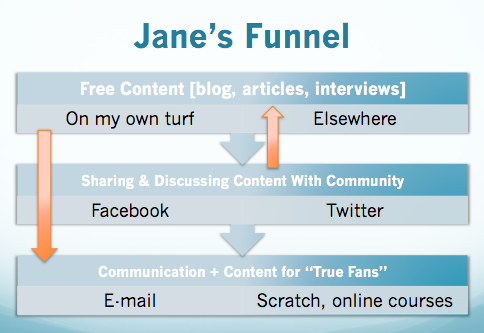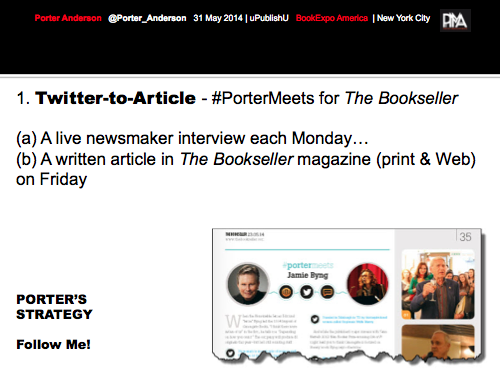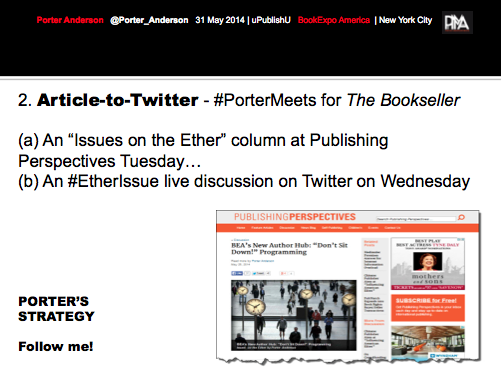Jane Friedman's Blog: Jane Friedman, page 162
June 12, 2014
What Is the Value of Traditional Publishers? [Smart Set]
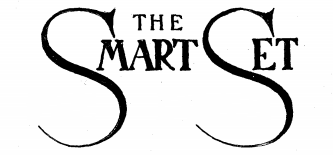
Welcome to the weekly The Smart Set, where I curate new smart reads about the publishing and media industry. I also point to issues and questions raised, and welcome you to respond or ask your own questions in the comments.
“To seek: to embrace the questions, be wary of answers.”
—Terry Tempest Williams
Advice to Publishers: Don’t Fight for Your Honor, Fight for Your Lives by Len Sherman
Sherman is on the faculty of the Columbia Business School, after a 30-year career in management. He delves into the deeper, historical, and endemic issues underlying the Amazon-Hachette conflict—useful for people who may not be aware of them. He concludes:
… this dispute is ultimately not about whether Amazon is a monopolist or monopsonist. Nor is it about whether Amazon is trying to use books as a loss leader to sell other merchandise or whether the company is treating Hachette, authors or its own customers fairly. It is also not about whether book publishers as currently configured are an essential bedrock of our society.
It is about whether publishers can retool their business capabilities to maintain a vital role in adding value to all stakeholders in an industry where books will increasingly be produced, marketed, reviewed and sold in profoundly different ways.
Sherman goes on to to say this means authors will be fundamentally questioning what value a traditional publisher offers—which, of course, is exactly what’s happening. You can’t attend a writing conference any more without hearing this question at every agent and editor panel. Read the full piece.
Thoughts & questions:
I suspect a publisher’s value may greatly depend on the genre/category in question, and how much consumer recognition the publisher’s brand has. I once wrote a long piece about the future of the author-publisher relationship (sadly, no longer available online, though I discuss here). I speculated that marketing would be the key value, but in the literary world, editorial taste and prestige is of much higher consideration. What do you think?
Here’s How the Recession Affected Jobs in News, Publishing, Advertising, and More by Caroline O’Donovan
The New York Times recently released a stunning visualization of job growth and decline in the U.S., based on government data. Below is a snapshot of the publishing/media environment. Newspaper, magazine, and book publishing jobs have declined while internet-related publishing jobs have grown.
Thoughts & questions:
I’m not sure how much the recession is really related to the declines seen here (as opposed to other fields the Times covered). Technological disruption of the market is obviously a big factor—perhaps the recession sped up the decline?
It’s tough to envision a job recovery for either newspaper or periodical publishers. What do you think?
Breaking Free: What Happened After I Left KDP Select by Nick Stephenson
This is a practical post, with transparent data, about one author’s sales after leaving Amazon KDP Select. The Select program demands that self-publishing authors sell exclusively through Amazon for 90 days; in return, Amazon gives you 5 days out of the 90 to make your book available for free (among a few other perks).
The ongoing debate among authors is whether this program is worthwhile or not. I think the big answer is “it depends,” but either way, I appreciate Stephenson showing the data of what happened. It also gives you some insight into how many sales you’re potentially missing by only distributing through Amazon. Stephenson concludes:
I’ve found that having books out of Select is (so far) having a positive effect. With KDP Select free days, I can drum up $1,500+ of extra cash in a 48-hour period, but that’s relying almost entirely on Bookbub, and things go back to normal almost immediately. … With books up on other vendors and a permafree [permanently free] title to keep readers coming in, I’m seeing much more consistent results. … Another ancillary benefit of permafree is email signups. With a link to my New Releases newsletter in the front and back of my book, I’m getting a lot of clicks – and a lot of signups. An extra 70 or 80 per day at the moment, which adds up pretty fast. It’s getting to the point where I can sell 50 – 100 books at full price from each email (once or twice per month), which also helps keep things going.
Thoughts & questions:
It feels like the tide is turning against the Select program, which makes me wonder what Amazon might do to increase its attractiveness. Indie authors have long wanted the ability to pre-order through Amazon (all the other retailers offer this functionality for self-pub titles), so perhaps that will be the next carrot. What do you think?
The post What Is the Value of Traditional Publishers? [Smart Set] appeared first on Jane Friedman and was written by Jane Friedman.
June 9, 2014
5 Mistakes You’ll Make on the Way to Publishing Success

Illustration by Helena Perez / Flickr
Today’s guest post is by Carmen Amato (@CarmenConnects), author of The Hidden Light of Mexico City and the Emilia Cruz series.
You have a polished manuscript in hand, and you’re ready to publish. But the road from finished manuscript to bestseller list is more like a labyrinth rather than a straight path.
There are dozens of choices and decisions ahead. Here are the 5 mistakes authors make along the way. Each represents a great learning experience, and ultimately, a steppingstone to your publishing success.
1. You’re in a rush.
As soon as that manuscript is ready, you’ll want to see it available for sale and on the shelves of Barnes & Noble. But don’t be in a rush to give up creative control of your work.
Take time to thoroughly research your publishing options. Ask questions of potential partners, such as agents and editors; get references for anyone you hire; realistically assess costs versus risks; and verify reliability of your partners. It’s often helpful to interview authors who have recently accomplished what you’ve just embarking upon, and find out what their lessons have been.
Before signing any kind of publishing or service contract, make sure you understand your legal responsibilities as an author. Consult an intellectual property rights attorney if you don’t understand copyright issues, royalties, and/or the legal constraints of any contract under consideration.
I made the mistake of rushing into a contract with a small publishing company without due diligence. If I had, I would have learned about the company’s problems. In the end, the book proof was a design disaster and the editor was missing in action, but because I had a good team of advisers outside of the publisher, I was able to withdraw from the contract and begin again.
2. You won’t have a marketing plan.
Most authors start off with a plan to use social media, have family and friends write book reviews, and do giveaways.
This general approach won’t be enough.
When I published my first book, a political thriller set in Mexico, I thought I had a great marketing plan. I’d target three different reader groups: the Latino audience, expatriates who love Mexico, and thriller readers. This market segmentation plan guided the blogs I contacted for reviews, the categories in which the book was placed on Amazon, what I blogged about, and who I followed on Twitter.
It all worked, up to a point. But it was a one-way approach that didn’t build a loyal readership. For that, I needed a strategic plan for long-term engagement, with tactical action items that didn’t swallow up all my time.
The best advice I found was Tim Grahl’s Your First 1,000 Copies and his Instant Bestseller online course. Following Tim’s blueprint, I was able to build a marketing plan, including an email list, to connect with readers on a monthly basis, offer free stories to introduce new readers to my mystery series, and repurpose blog content to extend my reach. The plan gives me an engagement vehicle—email—and specific steps to take to build connections with readers.
3. You’ll spend too much on promotions that don’t sell books.
Everyone wants your advertising dollars, and they’ll promise a lot with no guarantee of sales. Without a plan, you’ll be tempted to spend and spend. If you do, much of your money will be wasted because it won’t be targeted to your book’s specific audience.
Falling into this trap is easy because advertising takes so little effort. I spent $100 on a Goodreads ad, which is shown indiscriminately to users. No sales. I spent $200 on an ad for The Millions, before realizing that the site is more focused on literary fiction than a commercial mystery series. Again, no sales. My fellow authors have shared similar stories of either mistargeted advertising or ads aimed at everyone and no one.
To avoid this mistake, look for email newsletters, blog advertising, and other opportunities that cater to readers of your genre. The more specific the better. Stretch your advertising dollar as well, by including a clickable link in the book for readers to sign up for your email list. That’s the best way to connect with your readership.
4. You’ll think Twitter is for selling books.
A few years ago, when Twitter was still shiny and new, the micro-blogging service was hailed as a cost-free way to advertise and sell books. But a few marketers, including Tim Grahl, have looked at the sales statistics for sales generated by Twitter versus sales generated via emails. Bottom line, email far outsells Twitter.
The new #AmazonCart feature may help drive sales but that remains to be seen.
What makes Twitter essential for authors, in my view, is the ability to find book bloggers, guest posts, and research virtually any issue.
There are subtle ways to raise awareness of your books on Twitter and it is currently the second largest driver of traffic to my website. Highlight book quotes and catchy tag lines. Share links to blog posts and reviews, and build your virtual “street team” of fellow authors and reviewers. “Buy my book” tweets are obnoxious and to be avoided.
5. It’s easy to think no one is watching.
Building your author platform—website, social media accounts, guest blog posts, author pages on Amazon—is important because it projects what you represent as an author.
But if you are starting off, it’s easy to think that no one is watching. Unfortunately, if your dog is the star of your Facebook page; if your blog has a purple background with hard-to-read curly pink text; and if your Twitter picture is Benedict Cumberbatch as Khan, then people won’t be inclined to stick around.
Thankfully, this was a lesson I learned by watching, not by doing. Before creating my website and social media accounts, I researched the most successful authors in my genre. Like companies we recognize on sight—Coke, Disney, Apple—successful authors use design that is consistent across platforms to project quality, consistency, style, and genre.
Carry this consistent design over to your book covers. Using the same font for your name on covers, especially if you write a series, is a tried-and-true tactic to create name recognition. Repeat the same font and colors on your website and social media accounts.
You might not think anyone is watching. But they are. Make that first impression count.
Steppingstones
Mistakes are part of the process in today’s publishing landscape—things change quickly and new services come and go. If you make a few mistakes, don’t worry. Fix them and move on. You’ll only be smarter and more prepared for each new book launch.
The post 5 Mistakes You’ll Make on the Way to Publishing Success appeared first on Jane Friedman and was written by Carmen Amato.
June 5, 2014
How, When, and Where Does Quality Rise to the Top? [Smart Set]

Welcome to The Smart Set, a weekly series where I curate a selection of articles from the past week related to the publishing/media industry that merit your attention. I also point to what I see as the most interesting underlying questions, and welcome you to respond or ask your own questions in the comments.
“To seek: to embrace the questions, be wary of answers.”
—Terry Tempest Williams
LadyBits’ First and Last Year on Medium by Arikia Millikan
Medium is a start-up founded by Ev Williams, the guy behind Twitter, among other things. Medium is kind of like a blogging platform crossed with a publisher. Their site is nice to look at, and it’s structured differently than most content-driven sites. (It doesn’t really have a homepage or typical HuffPo-Buzzfeed qualities.)
Millikan was one of the first invited to be an editor at Medium, and she’s now departing. Her report is worth reading in full, but these are the choice paragraphs:
It would be comforting to believe that we live in a world where quality content chosen by experienced editors and authored by talented people will get more clicks than celebrity gossip, fear-mongering headlines, and snake oil salesmen peddling the next generation of tech bubble pyramid schemes. But that’s almost never the case. …
We were reminded that this was all an experiment, and if we would just put in more work something would probably go viral to make up for the stuff that didn’t. But if I wanted to produce things that were likely to go viral, I would have applied for a job at BuzzFeed. I started to consider the incompatibilities between the publishing company I was building at LadyBits, and the runaway platform Medium was evolving into.
Questions raised:
In book publishing specifically, I hear again and again that “Quality rises to the top.” I don’t think that’s true in book publishing, but let’s say it is. Is it true for online-driven content? And if not, what should online publishing business models look like?
How can a publishing business model can be successfully based on engagement (which Medium has turned toward—how long people stay at the site or keep reading?) rather than page views?
The Case Against Author Solutions, Part 1: The Numbers by David Gaughran
Gaughran has been an outspoken (and accurate) critic of Author Solutions (ASI) for a while now, and all of his posts covering ASI are worth reading. If you don’t know about ASI, they’re the largest provider of self-publishing services in the world, with many brand names (AuthorHouse, iUniverse, Xlibris, Archway, Trafford, and others).
Crunching the numbers, Gaughran reports on how much he estimates ASI is earning by selling marketing packages that have terrible return on investment. I look forward to reading part 2. If you know anyone considering ASI as a service provider, make sure they read Gaughran’s posts before committing.
Questions raised:
The company is facing a class-action lawsuit as a result of its questionable business practices. One wonders how much that does or will affect its business and reputation.
Penguin Random House is now the owner of Author Solutions. One also wonders how concerned they are about the reputation or business practices of the company—and how they envision its future.
The Scariest Chart in Mary Meeker’s Slide Deck for Newspapers Has Gotten a Little Scarier by Johsua Benton
Every year, Meeker covers trends in Internet usage and growth. One of the slides that is always passed around is this one—showing the % of attention for each medium versus the % of ad spend it enjoys. Note the polar opposites: print & mobile.
As usual, print is down in attention and ad dollars from prior years, though it seems to get more attention than it deserves. Also: no one has really figured out how to do effective mobile advertising.
Questions raised:
The biggest one: Who’s going to figure out how to monetize mobile through advertising?
Does print deserve the ad dollars it’s getting?
The post How, When, and Where Does Quality Rise to the Top? [Smart Set] appeared first on Jane Friedman and was written by Jane Friedman.
June 2, 2014
Understand Your Character’s Obsession
Fiction writers: How well do you know your protagonist? While you may have learned the basics of point of view, and can tell the story from your protagonist’s perspective, how does your protagonist see the events and details of the world around him?
Bret Anthony Johnston suggests, “Point-of-view is defined by obsession.” He writes in the latest Glimmer Train bulletin:
What do a narrator’s choices betray about the narrator’s head and heart, history and preoccupations, fears and desires? … Every detail confirms the POV character’s conscious and subconscious priorities. Our brains run on about 12 watts of power, which isn’t much at all, so to conserve energy, they’ve evolved to only process one thing at a time. Through a totally interesting concept called “inattentional blindness,” we filter out nonessential information while amplifying and concentrating on the stimuli that seems most crucial. This is point-of-view in its purest form.
Read more from Johnston, and try a writing exercise based on this principle.
To read more in the latest bulletin:
But If You Start Thinking by Ruth Ozeki
The Least Important Person in the Room by Douglas W. Milliken
The post Understand Your Character’s Obsession appeared first on Jane Friedman and was written by Jane Friedman.
May 30, 2014
Social Media 201: uPublishU Panel Preview
Tomorrow, I’m moderating a panel at BEA’s uPublishU on Social Media 201, featuring:
Porter Anderson
L.L. Barkat of Tweetspeak Poetry
Jeanne Bowerman of scriptmag.com
This post offers a sneak preview of what we’ll have to say.
Jane’s Funnel
Very often, when people talk about strategies on Facebook or Twitter, they’re discussed as if they exist in a vacuum and didn’t form part of a cohesive effort involving blog or book content.
The following chart illustrates how social media commonly serves as a place for me to discuss and share content appearing on my blog (or elsewhere), but also helps (new) people discover my content. “True fan” engagement typically happens through email or paid services.
L.L. Barkat’s Portrait of an Author
L.L. Barkat will discuss two portraits of authors who have published through her publisher, T.S. Poetry Press. Here’s one.
Poetry at Work by Glynn Young
2009: Glynn Young and Barkat meet via a blogging network. A Twitter party later that year results in the site Tweetspeak Poetry; Glynn helps manage.
2012 T.S. Poetry Press acquires Tweetspeak website. Glynn is asked to write articles on the topic of poetry at work.
2013: Tweetspeak creates and celebrates Poetry at Work Day and Take Your Poet to Work Day in January & July via social media.
2013 and early 2014: The book Poetry at Work is published in December 2013, and promoted with Poetry at Work Day via social media. Celebration goes around the world, with participation of the Scottish Parliament and England’s Virgin Trains as well as ABC News.
2014: Recognize the strong benefit of going beyond the social media audience: now beginning to engage in more traditional media in a targeted way—direct contacts to life coaches, HR professionals, organizational conflict resolution professionals, business strategists via phone and US mail.
Porter Anderson’s Twitter-to-Article (and Back Again)
These slides from Porter Anderson illustrate his strategy in developing cross-platform content that builds on social-media interaction.
How Jeanne Bowerman Got Big on Twitter
Jeanne will discuss the role Twitter has played in her career, and what her strategy has been. Here’s a preview:
I created my Twitter account to help get attention to our adaptation of the Pulitzer Prize-winning book, Slavery by Another Name. While I do talk about the screenplay on Twitter, my account has a general “theme” of screenwriting, screenwriting advice, being motivational, inspiring and accessible. People are drawn to my account because I interact and treat Twitter as if it’s my water cooler. My suggestion would be to create a “theme” for what your tweets will be, similar to how you create a “theme” for your website. Be consistent, informative but also show your personality. I get more followers by being ME than by tweeting out news. Decide what you want to let the public see and be brave in how far you’re willing to go. And, I tweet about liquor. Unprofessional? Maybe, but that’s how I met Jane.
With over 28K followers, I can’t possibly follow everyone back, but I do “follow” almost 9K. But that doesn’t mean I pay attention to all of them. I use well-thought-out lists to categorize the important ones so I don’t miss the people who share great content.
If you’re at uPublishU, please say hello and introduce yourself—and consider live-tweeting the panel for those who can’t attend. I’ll try to capture a decent audio recording and post it here after the show.
The post Social Media 201: uPublishU Panel Preview appeared first on Jane Friedman and was written by Jane Friedman.
May 29, 2014
What Does Innovation Look Like for Literary Publishing? [Smart Set]

Welcome to The Smart Set, a weekly series where I discuss some of the most interesting questions being raised by astute minds in writing, publishing, and media.
“To seek: to embrace the questions, be wary of answers.”
—Terry Tempest Williams
Literature Is Not the Same Thing as Publishing by Chris Fischbach
The publisher of Coffee House Press—a small, independent publisher based in Minneapolis—writes an essay at VQR on the evolution of their goals:
At Coffee House, we interrogated all our assumptions about the industry, how we do business, how we reach our goals. The largest assumption? That we publish books. Everything changed when we decided no, publishing books is not our goal; it’s a tactic we use to achieve our actual goal, which is to connect writers and readers.
Connecting writers and readers over the course of the decades, and continuing to do that, means delivering content however and wherever the reader or writer wants. But what is a publisher if you take books out of the equation? What’s the next step?
What does innovation look like in the context of literary publishing? Hint: It’s not e-books.
Fischbach offers specific examples of “not publishing books” that achieve the press’s mission. He also offers other excellent examples in the literary community, such as Tin House and Two Dollar Radio.
Questions raised:
I’m not sure that publishing proper has reached a point where literature is more about engagement, less about product. But what do you think?
What other publishers are flourishing under the engagement model rather than the product model?
How well can a corporate publisher apply the same engagement strategy as a smaller press like Coffee House?
Publishers’ Deal With the Devil by Ben Thompson
This is likely to be the only reference I ever make to the Amazon vs. Hachette dispute. Over at the Stratechery blog, Thompson concludes that publishers dug their own grave on this one, by insisting on DRM on ebooks:
Publishers could break the back of the Amazon monopsony today were they to start selling all of their books without DRM. Can’t find the book you want on Amazon? How about you simply visit the publisher’s site and buy it there. Or, as is more likely, visit the site of your favorite author.
Ah, but that’s the rub. The publishers need Amazon because they need the Kindle’s DRM, because they know without that artificial friction their contribution to a book’s fixed costs would become untenable.
Thompson goes on to say that the economics of publishers are wholly incompatible with the Internet, and proposes an unconventional way for them to thrive in the future.
Questions raised:
Is it possible that publishers may back off on their DRM stance?
Is boiling the entire situation down to DRM an oversimplification?
Subscription Services for Ebooks Progress to Becoming a Real Experiment by Mike Shatzkin
Another one of the Big Five publishers recently joined Oyster, making it the second one to do so. (The biggest New York house, Penguin Random House, has not joined.) Industry analyst Mike Shatzkin updates his thinking on whether these services have a future or not. If you listened to this podcast I co-hosted on ebook subscription services, then you know I am skeptical, unless the service is focused on a niche or community (rather than a mass-market approach, such as Oyster).
Questions raised:
What will it take for ebook subscription services to become widely popular with readers?
How problematic is it that current subscription services rely on “health club economics” to ensure profitability?
The post What Does Innovation Look Like for Literary Publishing? [Smart Set] appeared first on Jane Friedman and was written by Jane Friedman.
May 28, 2014
My Latest Writings & Ideas—Elsewhere

by archer10 (Dennis) / Flickr
This past week, I’ve been a guest at a range of sites. Here’s where you can find my latest musings on the future of publishing and more.
Stop Looking for Innovation on the Newsstand
In this piece for the Bo Sacks newsletter, I question why we’re using newsstand as a measuring stick for the health of the magazine industry—or as a way to determine value.
The Netflix of Ebooks
I’m proud to be an occasional co-host, with Glenn Fleishman, of The Periodicalist, a new podcast on the future of publishing. The first episode is all about ebook subscription services (e.g., Oyster). I expressed more of a pessimistic view than I actually have (we got on a roll), but regardless, the business model is problematic.
3 Insights That Lead to Successful Publishing Careers
This is an inspirational post, drawn from my observations of all types of writers and creative people. Read it at Writer Unboxed.
Social Media for Writers: Blogging
Over at Allison Tait’s site, I’m interviewed on 101 advice for bloggers.
The post My Latest Writings & Ideas—Elsewhere appeared first on Jane Friedman and was written by Jane Friedman.
May 23, 2014
Does an Author’s Gender Affect the Size of the Book Advance?

Debut novel author advance comparison by gender
I’ve written an analysis of debut novel advances based on gender—and genre—over at the Scratch blog. I was inspired by a Twitter conversation where authors wanted to know if being a man or a woman possibly affected the advance offered by a publisher.
I crunched the numbers from deal reports at Publishers Marketplace to see if any trends might reveal themselves. I think you’ll find the results quite interesting. Go read: Do Men Receive Bigger Book Advances Than Women?
The post Does an Author’s Gender Affect the Size of the Book Advance? appeared first on Jane Friedman and was written by Jane Friedman.
May 22, 2014
How Does a Print-Centric Publishing Culture Become Digital-First? [Smart Set]

Welcome to The Smart Set, a weekly series where I discuss some of the most interesting questions being raised by astute minds in writing, publishing, and media.
“To seek: to embrace the questions, be wary of answers.”
—Terry Tempest Williams
The Leaked New York Times Report Is One of the Key Documents of This Media Age by Joshua Benton
For anyone working in magazine, newspaper, or digital journalism, last week was a flurry of opinion and analysis on the New York Times Innovation Report, a nearly 100-page internal memo documenting how the NYT’s culture remains steadfastly print-centric. (There was also a lot of commentary last week about Jill Abramson’s departure from the NYT, but the two events are not connected.)
Some of my favorite tidbits-findings-commentary:
From the report: “The hardest part has been the realisation that you don’t automatically get an audience,” said Janine Gibson, editor-in-chief of the Guardian’s website. “For someone with a print background, you’re accustomed to the fact that if it makes the editors’ cut—gets into the paper—you’re going to find an audience. It’s entirely the other way around as a digital journalist. The realization that you have to go find your audience—they’re not going to just come and read it—has been transformative.”
From the report: “The Times doesn’t offer much of a career path for people working on the digital side of the newsroom. And many staffers feel like their skills are either undervalued, or misunderstood. One larger problem for the Times is that there is a shortage of people in senior positions who understand digital news, which also leaves the paper not knowing who should be promoted on the digital side, the report says. “The reason producers, platform editors and developers feel dissatisfied is that they want to play creative roles, not serve roles that involve administering and fixing. It would be like reporters coming here hoping to write features but instead we ask them to spend their days editing wire stories into briefs.”
Unsurprisingly, print accounts for a small percentage of New York Times readers; most readers are predominantly reading off their desktop computers, followed by mobile devices. Yet the Times remains a print-dominant culture; e.g., journalists get evaluated by the number of stories on A1, and stories get posted online in the evening (even though traffic is highest in the morning), as a result of print deadlines.
Fédéric Filloux: “Journalists are still too often picked for their writing capabilities while many other talents are needed. … In today’s print-oriented newsrooms, most writers and editors consider their jobs done once the story is filed in the CMS (Content Management System). Unfortunately, in every fast-growing digital media outlets such as Buzzfeed, The HuffPo, Politico, Quartz, Vox Media, now part of the competitive landscape, throwing the story online is actually just the beginning. The ability to cause a news item to reverberate around the social sphere is now as important as being a good writer.”
Filloux called the report “a plea for the necessity of dumping the obdurate print-first obsession.” And some of his own questions are encapsulated below.
Questions raised:
What should the NYT’s primary goals be in a world saturated with commodity news?
What should be their key performance indicators—measurements of success?
Should the paper continue to be printed daily?
How much do these same concerns apply to book publishing?
Why the Authors Guild Is Wrong About the Future by Brad King
This week, a new U.S. authors advocacy organization launched, the Authors Alliance. Before they had even thrown their launch party (on May 21), the Authors Guild—the prevailing advocacy group for commercial authors—came out with a letter of attack at their blog. They accuse the Authors Alliance of being for authors who prefer to “give your work away for free” and discourage authors from joining.
Their characterization is misleading at best, blatantly dishonest at worst.
Author and professor Brad King, someone with a career’s worth of history in publishing and media—and lots of insight into the issues at stake—wrote a post over at The Geeky Press (his newly formed authors collective), explaining why the Authors Guild was wrong to attack the Authors Alliance. The issues are very complex, so I’ll let him explain what’s going on.
Questions raised:
Can’t we all just get along?
How much is it a sign of weakness that the Authors Guild clearly feels so threatened it would lash out with a FUD strategy? What about a collaborative approach instead?
The post How Does a Print-Centric Publishing Culture Become Digital-First? [Smart Set] appeared first on Jane Friedman and was written by Jane Friedman.
May 20, 2014
How to Write a Competitive Title Analysis

Steven de Polo / Flickr
The following post has been excerpted and adapted from The Author Training Manual by Nina Amir, recently released by Writer’s Digest Books.
If you’re embarking on a nonfiction book project, your analysis of the competitive landscape is critical, whether you self-publish or traditionally publish. You need to understand and be able to explain how your book stacks up against all the others.
If you pitch your book to editors and agents, one component of your book proposal [see Jane's 101 post on book proposals] is the competitive title analysis. The goal is to evaluate how unique and necessary your book is in the marketplace, or how to make it so.
1. Determine the book’s category.
Where in a bookstore will you find your book shelved? (Examples: Religion, History, Business, Self-Help.) If you don’t know, ask a bookstore clerk or a librarian. Tell them about your book, and ask where it would be located or how it would be categorized. Then focus your competitive title search on this particular category.
2. Compile a list of competitive and complementary titles.
Look for competing titles in bricks-and-mortar bookstores, libraries, online bookstores, and online community sites—including Amazon, Barnes & Noble, LibraryThing, Goodreads, Redroom, BookDepository.com, and NetGalley. Don’t forget to Google your topic and see what comes up as well.
Come up with a list of 10–15 books you consider competitive or complementary to yours—books that cover the same type of information or that tell the same type of story. Then narrow the list down to 5–10 that are closest in subject matter or storyline. List these by bestseller status or by date of publication. Keep track of the following data:
title and subtitle
author
publisher
copyright year
number of pages
format (paperback, hardcover, etc—along with notes about any special packaging)
price
If you have trouble discerning whether a title belongs on this list, consider the following criteria:
If a reader buys your book instead of another book, that other book is your competition.
If a reader is interested in buying your book, what other books might he buy to gain different information? These are complementary titles.
You can also go to Amazon and look at the section on a particular book’s page that says: “Customers Who Bought This Item Also Bought.” These may be complementary or competing books.
3. Closely study the competition (and learn from it).
For each competitive title, study the table of contents, the promises they make on their back covers, the introductions and forewords, the author’s bio, special features (quotations, a workbook element, case studies, tips, or tools), the style or tone, and so on.
Consider these factors about the competing books you have identified:
How it is different from the book you want to write?
How it is similar to the book you want to write?
Is the scope of the book different? How so?
Does it have different benefits? What are they?
What are its pros and cons?
How would you improve it?
What do you like about it? Dislike?
What promises does the author make to readers? What promises does the author fail to make that he could or should (or that you can)?
What are the author’s credentials (or lack of credentials)?
Also study the reviews of bestselling books in your category. You can learn a lot about a book by what others say about it—and what readers think is good, bad, or missing. Look at your project and ask yourself how you can make sure your book improves on these issues—or addresses the issues in a positive manner.
In your final competitive title analysis, describe each competing book’s standout qualities, and the ways in which it is similar to your idea or how it helps readers. Then add a brief paragraph about how your book is unique or different in comparison. Don’t forget to include the basic data (publisher, copyright year, format, etc).
4. Closely study the competing authors.
Compare your credentials to that of the authors of the competing books you have identified. Visit their website and social media accounts. Then consider these questions:
How do you differ from them, or how are you similar to them?
Will it help you or hurt you to have different qualifications or similar ones?
Do you have the experience to join the ranks of these other authors?
What do you need to do or be to compete with them?
What would you have to do to make yourself stand out from the other authors?
Do you need a larger platform? In what way?
Do you need to write a series? Why or why not?
Parting advice
Based on your research, you may realize you need to make changes to your concept, such as offering a different perspective or providing more comprehensive or more timely information than other competing titles. Whether pitching to a publisher or not, your book should seek to fill a clearly identified need (or gap) in the market and have a unique selling proposition that other titles cannot match.
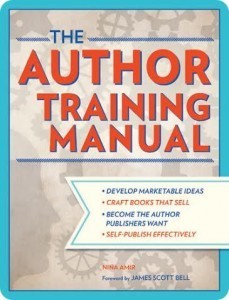 The Author Training Manual by Nina Amir helps you develop marketable ideas, learn how to pitch publishers, and also how to effectively self-publish. Click here for a sample chapter or to learn more.
The Author Training Manual by Nina Amir helps you develop marketable ideas, learn how to pitch publishers, and also how to effectively self-publish. Click here for a sample chapter or to learn more.
The post How to Write a Competitive Title Analysis appeared first on Jane Friedman and was written by Nina Amir.
Jane Friedman
- Jane Friedman's profile
- 1882 followers






